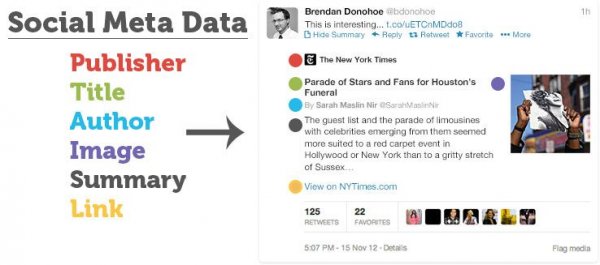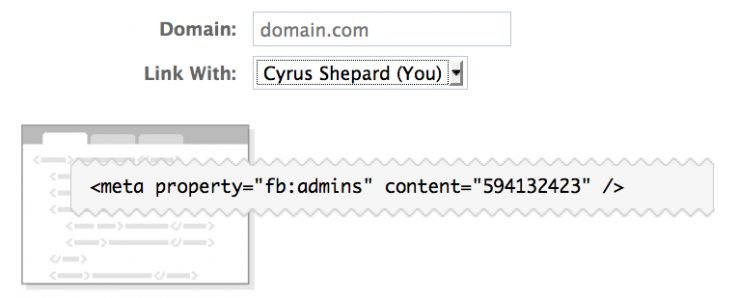Home • Online Tips • SEO
Social Meta meta Tags for Twitter, Google+, Facebook and More

 At Moz, we strive to include social media metadata in all new pieces of content that we publish. This allows us to optimize for sharing Twitter, Facebook, Google+ and Pinerest by defining exactly how titles, descriptions, images and more appear in social streams.
Think of it as conversion rate optimization for social exposure.
The implications for SEO are also significant. We know from experience and studies that the right data, including optimized images, helps content to spread, which often leads to increased links and mentions.
Knowing exactly which social meta tags to include can be confusing even to experienced webmasters.
For the rest of us, consider the different structures supported by the major social platforms:
Twitter Cards: Summaries, Images, Galleries, Apps, Video, Audio, and Products
Pinterest Rich Pins: Products, Recipes, Movies, and Articles
Google+: Articles, Blog, Book, Event, Local Business, Organization, Person, Product, and Reviews
Facebook: Articles, Photos, Audio, Video, and more
To help ease this problem, I created four social media tag templates that you can fill out, customize for your own use, and share with your team and others.
At Moz, we strive to include social media metadata in all new pieces of content that we publish. This allows us to optimize for sharing Twitter, Facebook, Google+ and Pinerest by defining exactly how titles, descriptions, images and more appear in social streams.
Think of it as conversion rate optimization for social exposure.
The implications for SEO are also significant. We know from experience and studies that the right data, including optimized images, helps content to spread, which often leads to increased links and mentions.
Knowing exactly which social meta tags to include can be confusing even to experienced webmasters.
For the rest of us, consider the different structures supported by the major social platforms:
Twitter Cards: Summaries, Images, Galleries, Apps, Video, Audio, and Products
Pinterest Rich Pins: Products, Recipes, Movies, and Articles
Google+: Articles, Blog, Book, Event, Local Business, Organization, Person, Product, and Reviews
Facebook: Articles, Photos, Audio, Video, and more
To help ease this problem, I created four social media tag templates that you can fill out, customize for your own use, and share with your team and others.
How to use these templates
Simply copy and paste the template into the text editor of your choice. Make sure to replace any orange or green text with your own data, and customize, eliminate or add any tags you find necessary. The first three of these templates are optimized using a typical "article" markup and data, ideal for blog posts and most written content. The final template contains markup for product pages.For other post types, such as book or recipes, refer to documentation linked at the end of this post for reference on what to customize.1. The Minimal Template
This slimmed back version runs lean and fast. It contains a bare minimum of data for optimized sharing across Twitter, Facebook, Google+ and Pinterest. Title tags and meta descriptions are included even though they aren't technically social media meta tags. This is because they can be used by Google+ and other social media platforms, and it is best practice to include them on every page you publish. Minimum Social Media Tag Template: Article<!-- Place this data between the <head> tags of your website --> <title>Page Title. Maximum length 60-70 characters</title> <meta name="description" content="Page description. No longer than 155 characters." /> <!-- Twitter Card data --> <meta name="twitter:card" value="summary"> <!-- Open Graph data --> <meta property="og:title" content="Title Here" /> <meta property="og:type" content="article" /> <meta property="og:url" content="http://www.example.com/" /> <meta property="og:image" content="http://example.com/image.jpg" /> <meta property="og:description" content="Description Here" />
2: The Standard Template
The standard template represents a more robust implementation of social tags and is meant to work across all platforms. In addition to all of the features of the mimimal template above, the standard template includes the following: - The basic Twitter Summary card - Twitter thumbnail image - Facebook Page Insights Standard Social Media Tag Template: Article<!-- Place this data between the <head> tags of your website --> <title>Page Title. Maximum length 60-70 characters</title> <meta name="description" content="Page description. No longer than 155 characters." /> <!-- Twitter Card data --> <meta name="twitter:card" content="summary"> <meta name="twitter:site" content="@publisher_handle"> <meta name="twitter:title" content="Page Title"> <meta name="twitter:description" content="Page description less than 200 characters"> <meta name="twitter:creator" content="@author_handle"> <-- Twitter Summary card images must be at least 120x120px --> <meta name="twitter:image" content="http://www.example.com/image.jpg"> <!-- Open Graph data --> <meta property="og:title" content="Title Here" /> <meta property="og:type" content="article" /> <meta property="og:url" content="http://www.example.com/" /> <meta property="og:image" content="http://example.com/image.jpg" /> <meta property="og:description" content="Description Here" /> <meta property="og:site_name" content="Site Name, i.e. Moz" /> <meta property="fb:admins" content="Facebook numeric ID" />
3: The Full Monty
This is the monster! In addition to all the data contained in the standard template, the full template contains: - Google Authorship and Publisher Markup. Although this data doesn't change your content appearance in Google+, it potentially add links to your Google+ pages in search results. - Schema.org article markup - Twitter Summary card with large image - Expanded Open Graph article data Full Social Media Tag Template: Article<!-- Update your html tag to include the itemscope and itemtype attributes. --> <html itemscope itemtype="http://schema.org/Article"> <!-- Place this data between the <head> tags of your website --> <title>Page Title. Maximum length 60-70 characters</title> <meta name="description" content="Page description. No longer than 155 characters." /> <!-- Schema.org markup for Google+ --> <meta itemprop="name" content="The Name or Title Here"> <meta itemprop="description" content="This is the page description"> <meta itemprop="image" content="http://www.example.com/image.jpg"> <!-- Twitter Card data --> <meta name="twitter:card" content="summary_large_image"> <meta name="twitter:site" content="@publisher_handle"> <meta name="twitter:title" content="Page Title"> <meta name="twitter:description" content="Page description less than 200 characters"> <meta name="twitter:creator" content="@author_handle"> <!-- Twitter summary card with large image must be at least 280x150px --> <meta name="twitter:image:src" content="http://www.example.com/image.html"> <!-- Open Graph data --> <meta property="og:title" content="Title Here" /> <meta property="og:type" content="article" /> <meta property="og:url" content="http://www.example.com/" /> <meta property="og:image" content="http://example.com/image.jpg" /> <meta property="og:description" content="Description Here" /> <meta property="og:site_name" content="Site Name, i.e. Moz" /> <meta property="article:published_time" content="2013-09-17T05:59:00+01:00" /> <meta property="article:modified_time" content="2013-09-16T19:08:47+01:00" /> <meta property="article:section" content="Article Section" /> <meta property="article:tag" content="Article Tag" /> <meta property="fb:admins" content="Facebook numberic ID" />
Bonus: The Product Template
For merchants, product markup is very popular, and usually easy for developers to implement in their shopping cart software. The product template differs from article markup in only a few ways: - Modified <html> tag to reflect schema.org product data - Twitter Product Card includes required data labels - Open Graph data includes price and currency data Product Social Media Tag Template<!-- Update your html tag to include the itemscope and itemtype attributes. --> <html itemscope itemtype="http://schema.org/Product"> <!-- Place this data between the <head> tags of your website --> <title>Page Title. Maximum length 60-70 characters</title> <meta name="description" content="Page description. No longer than 155 characters." /> <!-- Schema.org markup for Google+ --> <meta itemprop="name" content="The Name or Title Here"> <meta itemprop="description" content="This is the page description"> <meta itemprop="image" content="http://www.example.com/image.jpg"> <!-- Twitter Card data --> <meta name="twitter:card" content="product"> <meta name="twitter:site" content="@publisher_handle"> <meta name="twitter:title" content="Page Title"> <meta name="twitter:description" content="Page description less than 200 characters"> <meta name="twitter:creator" content="@author_handle"> <meta name="twitter:image" content="http://www.example.com/image.html"> <meta name="twitter:data1" content="$3"> <meta name="twitter:label1" content="Price"> <meta name="twitter:data2" content="Black"> <meta name="twitter:label2" content="Color"> <!-- Open Graph data --> <meta property="og:title" content="Title Here" /> <meta property="og:type" content="article" /> <meta property="og:url" content="http://www.example.com/" /> <meta property="og:image" content="http://example.com/image.jpg" /> <meta property="og:description" content="Description Here" /> <meta property="og:site_name" content="Site Name, i.e. Moz" /> <meta property="og:price:amount" content="15.00" /> <meta property="og:price:currency" content="USD" />
Tools for testing and approval
A. Twitter Validation Tool
https://dev.twitter.com/docs/cards/validation/validator Before your cards show on Twitter, you must first have your domain approved. Fortunately, it's a super-easy process. After you implement your cards, simply enter your sample URL into the validation tool. After checking your markup, select the "Submit for Approval" button.B. Facebook Debugger
https://developers.facebook.com/tools/debug You don't need prior approval for your meta information to show on Facebook, but the debugging tool they offer gives you a wealth of information about all your tags and can also analyze your Twitter tags.C. Google Structured Data Testing Tool
http://www.google.com/webmasters/tools/richsnippets Webmasters traditionally use the structured data testing tool to test authorship markup and preview how snippets will appear in search results, but you can also use see what other types of meta data Google is able to extract from each page.D. Pinterest Rich Pins Validator
http://developers.pinterest.com/rich_pins/validator/ Like Twitter, Pinterest requires an approval process to enable Rich Pin functionality. Use the Rich Pin Validator tool to test your data markup and apply for approval at the same time.Tips and best practices
Optimizing for images
The image you link to in your social data does not actually have to be on the page, but it should represent your content well. The image allows you to controll what people see when they share your content, so it's important to use quality images. Every social platform has different standards for sizing. Typically, it's easier to keep it simple and choose one image size that will work for all services. - Twitter thumbnail: 120x120px - Twitter large image: 280x150px - Facebook: Standards vary, but an image at least 200x200px works best. Facebook recommends large images up to 1200x630px wide. In short, larger images offer you the most flexibility. When in doubt, test each page using the appropriate tool below to see exactly how your images will appear in snippits. The importance of Open Graph data If you could choose only one type of meta data to include, your best bet is Open Graph. That's because all the platforms can use it as a fallback, including Twitter to a large degree.Facebook page insights
The meta property "fb:admins" requires that you enter your numeric Facebook id number, and gives you access to analytics about how your website content is shared on Facebook. Read more about Page Insights, including how to set it up and discover your numeric id.
Further resources
Use these templates as a starting point, but you can customize them in millions of ways. A few valuable resources to aid your journey: https://moz.com/blog/the-web-developers-seo-cheat-sheet-2013-edition http://www.iacquire.com/blog/18-meta-tags-every-webpage-should-have-in-2013/ https://dev.twitter.com/docs/cards http://ogp.me/ https://developers.google.com/ /web/snippet/ http://business.pinterest.com/rich-pins/- University
- Online Tips
- Engineering
- Programming
- General Subjects
- Science
- News
- Jobs
- Commerce
- General Knowledge
- Story, Tales & Poem
- Software Application
- Framework
- Operating System
- Database
- Networking
- Quiz
- Generic POS + ERP

Comments 0